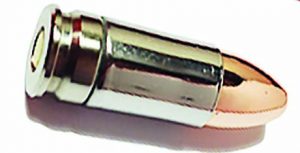by Art Merrill | Contributing Editor
 What innovations can you name that have completely changed cartridge technology?
What innovations can you name that have completely changed cartridge technology?
Manufacturers–especially small, unknowns—routinely introduce new products they claim are game-changers, and it would be an interesting discussion indeed to attempt agreement on a single product that forever changed the world of recreational shooting. What shall we use as our standard of reference – the invention of smokeless powder? The self-contained metallic cartridge case?
Of the latter, we’ve seen a few novelties, such as “caseless ammo” (Trounds), the self-propelled bullet (Gyro Jet) and the electric primer (Remington EtronX) appear with a bang and fade without an echo (the EtronX is still around, but is hardly ubiquitous with primers going for $200 per thousand). The exigencies of world war introduced steel cases, which remain with us as a cheap, “not-worth-reloading” alternative to brass. Aluminum case ammo is another throwaway option. Ammo featuring a polymer case married to an aluminum/alloy case head is out there somewhere, but is, alas, also not reloadable. Nothing has yet replaced the brass cartridge case, and especially not for reloading.
But a small start-up company, Shell Shock Technologies (SST), claims it has now done so, that its 9mm cartridge cases offer superior performance and lesser cost than brass. If true, then the brass cartridge case may finally retire in obsolescence.
SST joins a nickel plated aluminum case head to a nickel alloy/stainless steel cylinder to make what it calls the NAS3 (Nickel Alloy Shell) case. With three dissimilar metals in contact with each other, all that’s needed to introduce galvanic corrosion is a bit of water moisture to act as an electrolyte. However, SST claims their cases are more corrosion resistant than brass cases. (As an aside, the nickel plate also permits anodizing the case head in different colors for rapid ID purposes.)
SST has a few more eyebrow-raising claims, as well: NAS3 cases are half the weight of brass while providing twice the tensile strength and greater elasticity than brass. Wall thickness is uniform and provides slightly more internal volume while maintaining a SAAMI spec outer dimension. The design prevents case “ballooning” in semi-autos that don’t support case heads at the breech. Company literature says the case’s larger flash hole “is ideal for the new generation of environmentally friendly primers,” apparently a reference to diazodinitrophenol (DDNP) primers, which don’t contain lead styphnate but need the larger flash hole to achieve reliable ignition.
The next claim is of particular interest to handloaders; SST says, “NAS3 cases will not split, chip, crack or grow (stretch) and are fully reloadable with SST’s dies. Testers have reported up to 40 reloads.”
Now, that’s a claim we can easily test, and we plan to do so. Watch this space for a future review of SST’s NAS3 case technology – it’ll take a while to shoot and reload a batch of 9mm 40 times.



